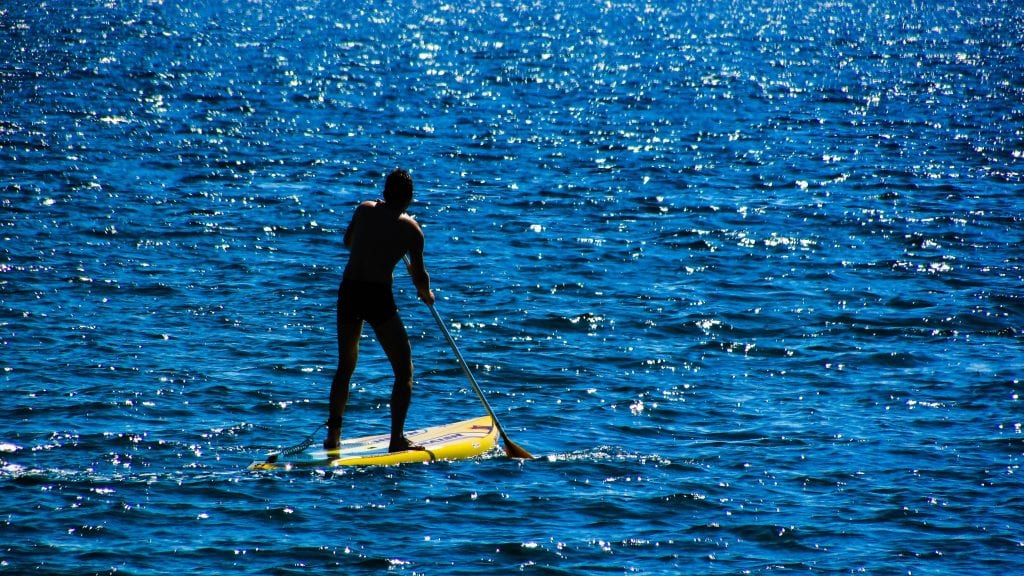Go down to your nearest seaside resort or lake on a glorious summer day and you can’t help noticing the increasing amount of stand up paddle boarders out on the water.
Stand up paddle boarding (SUP) has grown in leaps and bounds because of its appeal for all ages and skill levels and fun factor. It’s built-in benefit results in a full-on body core workout as well as a way to experience the fresh air and the beauty of the great outdoors.
There’s nothing better than that sense of freedom that paddle boarding brings when you’re out on the open water and exploring areas of the coast that are inaccessible on foot. You can even transport a friend or your trusty dog to share in the experience. Many people take what they need on longer paddle board treks in a dry bag to keep things from getting wet. You may want to have a look at these as an essential part of your kit later in your research to give you an idea of what’s available.

Which Paddle Board Should I Buy?
This depends on what you’re using it for. Are you looking to go on long adventures or touring? Or are you looking for something to generally paddle around on in the shallows? You could be looking further afield and like the look of surfing with your board and there’s a specific board for all of these needs.
Let’s look at a few design types because stand up paddle boards come in all shapes and sizes. There are two distinctive types of paddle boards, the most popular is the epoxy or hard type and is built like a traditional surfboard being fiberglass wrapped around an EPS foam core. They have one or more fins to help them track through the water.
A new paddle board construction was born in 2014 and this was the inflatable design. It opened up new horizons for aspiring paddlers, giving them an opportunity to transport their boards, with ease as they can mostly be rolled up and fit into a backpack.
Stand up paddle boards are much thicker on average than surfboards. Typically, paddle boards range from 8 to 12 feet long – 28 to 32 inches wide, and 4 to 6 inches in depth.
A longer thicker and wider board will offer the greatest stability, this being ideal for beginners to grow accustomed to learning paddle board basics in calm waters. As your skill level grows you can progress to a smaller board and there are many to consider – the all round shape being the most popular.
Here’s a basic list of 7 types of boards on the market to help you make a choice.
All Around paddle boards
These are perfect for SUP beginners and are the most common type of paddle board.
They can be used in all conditions from the sea to inland waters areas. All round boards can be used for all sorts of activities including paddle board touring where you can carry your own supplies, paddleboard yoga, paddleboard fishing, paddle board surfing
Inflatable paddle boards
Sales of these have increased exponentially as they’re easiest to store and transport and can roll up to the size of a sleeping bag they often come with a fitted carry bag. Another advantage is that they are super durable and won’t get damaged if they’re dropped.
Fishing paddle boards
Also great for beginners – with a wider deck pad for more space these can include usefull features like Scott Mount attachments, fishing rod holders and bait trays.
Ask anyone who fishes from a paddle board about the many benefits versus fishing from or a boat and they’ll tell you that you cant beat this method.
Yoga paddle boards
These have an large deck pad and are ideal for beginners, they allow more room for your yoga flow. Inflatables are better for SUP yoga because they sit higher up on the water keeping you stable and dry. This is the reason that many yoga enthusiasts are choosing water over land.
Touring paddle boards
If you’re looking to go long distance paddling adventures then this is the board to consider.
These boards have a displacement hull for better tracking, they are longer, narrower and have a pointed nose.
Surf paddle boards
These maneuverable and reponsive boards are designed for paddle board surfing waves. However they are more challenging to ride because they lack the same stability as the affor mentioned designs. Once you’ve mastered its quirks though, they are perfect for the thrill of wave riding.
Racing paddle boards
These are the longest paddle boards and are designed for their speed and glide efficiency during race competitions. They have a pointed nose and a hull for efficiency through the water which makes them ideal for long ditances. These are advanced boards and not really suitable for beginners.
